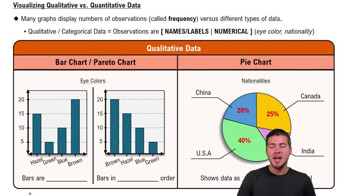Standard Deviation One way to get a very rough approximation of the value of a standard deviation of sample data is to find the range, then divide it by 4. The range is the difference between the highest sample value and the lowest sample value. In using this approach, what value is obtained from the sample data listed in Exercise 1 “IQ Scores”?
Table of contents
- 1. Intro to Stats and Collecting Data1h 14m
- 2. Describing Data with Tables and Graphs1h 55m
- 3. Describing Data Numerically2h 5m
- 4. Probability2h 16m
- 5. Binomial Distribution & Discrete Random Variables3h 6m
- 6. Normal Distribution and Continuous Random Variables2h 11m
- 7. Sampling Distributions & Confidence Intervals: Mean3h 23m
- Sampling Distribution of the Sample Mean and Central Limit Theorem19m
- Distribution of Sample Mean - Excel23m
- Introduction to Confidence Intervals15m
- Confidence Intervals for Population Mean1h 18m
- Determining the Minimum Sample Size Required12m
- Finding Probabilities and T Critical Values - Excel28m
- Confidence Intervals for Population Means - Excel25m
- 8. Sampling Distributions & Confidence Intervals: Proportion1h 25m
- 9. Hypothesis Testing for One Sample3h 29m
- 10. Hypothesis Testing for Two Samples4h 50m
- Two Proportions1h 13m
- Two Proportions Hypothesis Test - Excel28m
- Two Means - Unknown, Unequal Variance1h 3m
- Two Means - Unknown Variances Hypothesis Test - Excel12m
- Two Means - Unknown, Equal Variance15m
- Two Means - Unknown, Equal Variances Hypothesis Test - Excel9m
- Two Means - Known Variance12m
- Two Means - Sigma Known Hypothesis Test - Excel21m
- Two Means - Matched Pairs (Dependent Samples)42m
- Matched Pairs Hypothesis Test - Excel12m
- 11. Correlation1h 6m
- 12. Regression1h 50m
- 13. Chi-Square Tests & Goodness of Fit1h 57m
- 14. ANOVA1h 57m
1. Intro to Stats and Collecting Data
Intro to Stats
Problem 2.CRE.4b
Textbook Question
In Exercises 1–5, use the data listed in the margin, which are magnitudes (Richter scale) and depths (km) of earthquakes from Data Set 24 “Earthquakes” in Appendix B
[Image]
Data Type
b. For the listed earthquake depths, are the data categorical or quantitative?
 Verified step by step guidance
Verified step by step guidance1
Understand the difference between categorical and quantitative data: Categorical data represent characteristics or qualities that can be divided into groups, while quantitative data represent numerical values that can be measured and ordered.
Identify the nature of the data in question: The problem refers to earthquake depths, which are measured in kilometers.
Determine if the data are numerical: Since depths are given in kilometers, they are numerical values that can be measured and ordered.
Classify the data type: Since the earthquake depths are numerical and can be measured, they are considered quantitative data.
Conclude that the earthquake depths are quantitative data because they represent measurable numerical values.
 Verified video answer for a similar problem:
Verified video answer for a similar problem:This video solution was recommended by our tutors as helpful for the problem above
Video duration:
1mPlay a video:
Was this helpful?
Key Concepts
Here are the essential concepts you must grasp in order to answer the question correctly.
Categorical Data
Categorical data refers to variables that can be divided into distinct categories or groups. These data types are qualitative and describe characteristics or attributes, such as colors, names, or labels. They do not have a numerical value or order, making them unsuitable for arithmetic operations. Examples include gender, type of car, or earthquake classification by region.
Recommended video:
Guided course

Visualizing Qualitative vs. Quantitative Data
Quantitative Data
Quantitative data consists of numerical values that represent quantities or amounts. These data types can be measured and ordered, allowing for arithmetic operations. Quantitative data can be further divided into discrete data, which are countable, and continuous data, which can take any value within a range. Examples include height, weight, and earthquake depths measured in kilometers.
Recommended video:
Guided course

Visualizing Qualitative vs. Quantitative Data
Richter Scale
The Richter scale is a logarithmic scale used to measure the magnitude of earthquakes. It quantifies the energy released by an earthquake, with each whole number increase representing a tenfold increase in measured amplitude and roughly 31.6 times more energy release. Understanding the Richter scale is crucial for interpreting earthquake data, as it provides a standardized method to compare the size of different seismic events.
Recommended video:
Guided course

How to Create Histogram - TI-84 Calculator

 2:13m
2:13mWatch next
Master Introduction to Statistics Channel with a bite sized video explanation from Patrick
Start learningRelated Videos
Related Practice
Textbook Question
